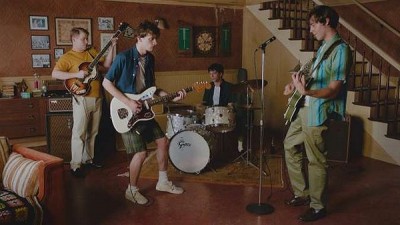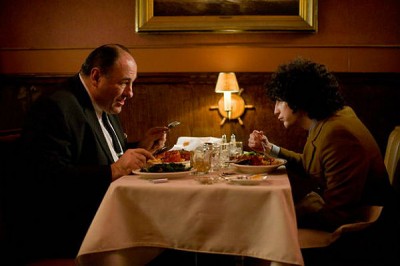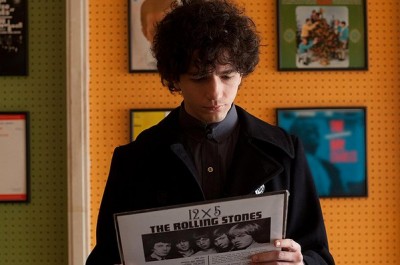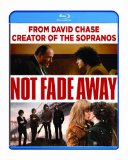| Reviews & Columns |
|
Reviews DVD TV on DVD Blu-ray 4K UHD International DVDs In Theaters Reviews by Studio Video Games Features Collector Series DVDs Easter Egg Database Interviews DVD Talk Radio Feature Articles Columns Anime Talk DVD Savant Horror DVDs The M.O.D. Squad Art House HD Talk Silent DVD
|
DVD Talk Forum |
|
|
| Resources |
|
DVD Price Search Customer Service #'s RCE Info Links |
|
Columns
|
|
|
Not Fade Away
THE MOVIE:
Please Note: The images used here are taken from promotional materials, not the Blu-ray edition under review.

I hate to fault a movie for trying to do too much, because so many movies don't try to do hardly anything at all, but that's exactly how Sopranos-creator David Chase fumbles his reels with Not Fade Away, his feature debut as a writer and director--there's just too damn much going on. For his initial foray on the big screen, he tries to encapsulate the entire experience of 1960s suburban New Jersey into under two hours. That means rock 'n' roll, the generation gap, the sexual revolution, racial politics, and Vietnam, not to mention the more general problems of entering adulthood, much less doing so at the end of a period of social turmoil.
Not Fade Away begins by highlighting two important events: the death of John F. Kennedy and the arrival of the Beatles. Both capture the imagination of young Douglas (John Magaro, Liberal Arts), and both provide some kind of solution to what then is his most devastating problem: getting Grace Dietz (Bella Heathcote, Dark Shadows) to stop paying attention to jocks and pay attention to him. Douglas fancies himself a drummer, and soon he is playing in one of the area's popular bands, fronted by his friend Eugene (Boardwalk Empire's Jack Huston). After Eugene commits a party foul with a joint, Douglas has to step up to the microphone, prompting a shift in band dynamics. The group has a new lead singer.
Not Fade Away charts several years in Douglas' development, following his evolution from awkward rock poseur to looking legitimately good in his counterculture lifestyle. One of the final images of the film is him standing on the Sunset Strip, flanked by a billboard for The Graduate, before crossing the street to disappear somewhere beyond the Cinerama Dome, leaving his rockstar dreams in a store window behind him. It's 1967 by that point, and symbolism wasn't subtle--even if Chase's handling of it actually is.

Still, that's a rather large canyon to traverse. Four years is a long time in any adolescence, and the upheaval of the 1960s meant styles and philosophies were changing daily. As Douglas' band progresses (on the soundtrack they are called The Twylight Zones, in tribute to Douglas' beloved Rod Serling, though I don't recall it ever being mentioned in the movie), so too does society, though not necessarily the version of it that exists in his home. The boy regularly clashes with his father (James Gandolfini), particularly once the youngster drops out of college to chase his dreams full-time. It's an interesting relationship, but one that never gets its due. There is no common ground forged between the two men, which may be true to life, they can love each other without ever agreeing, but they never really find mutual honesty or respect, and that ends up being unsatisfying in terms of narrative. Even the father's terminal illness fails to bring them any closer. It's a plot thread that never gets sewn into Chase's overall tapestry. It should be important, but it's not.
If that were the only thing left dangling, that would be fine, but Chase only allots himself the minimum amount of time to poke at any of the multiple elements that comprise Not Fade Away, suggesting he was unsure of what he really wanted to say with the movie. One suspects there is a smidgen of autobiography in this script, which makes it all the more perplexing that the director frames the tale using voiceover narration from Douglas' younger sister (Meg Guzulescu). Presumably, her impressionable eyes are meant to give us an impartial yet parallel view to her brother's growth through the period, but this facet of the telling is forgotten for long stretches. The kid closes the movie, just as she opens it, but if ever there was a WTF? finale, it's Guzulescu dancing us out while the Sex Pistols butcher "Road Runner." (And I say that as a staunch defender of the last scene of The Sopranos).
All that not withstanding, I still enjoyed Not Fade Away quite a bit. It may be a big lumbering mess, but it's an extremely watchable lumbering mess. All the parts work, even if they don't all get to fulfill their intended jobs. Front to back, the cast is excellent, with Huston, Gandolfini, and The Guard's Dominique McElligott all standing out in supporting roles. John Magaro also shows an impressive ability to develop a character, taking Douglas from gawky teen to confident young man and selling both sides with equal affinity. (You don't think he'll ever be a convincing frontman in those early scenes, but trust the dude, he'll get you there.)
All of the various story elements are also handled with a deft and intelligent hand. Any one of the many subplots could have been broken off and transformed into its own movie. Or better yet, another long-form miniseries, the kind of thing David Chase knows backwards and forwards. I'd watch a weekly TV show about a band in New Jersey and their growing pains and how their vision for the future clashes with their parents' memories of the past. Hey, HBO, you looking for your equivalent of Mad Men? Bada-bing, got it right here!

THE BLU-RAY
Video:
Not Fade Away gets the kind of high-definition transfer befitting a current studio release. Paramount rolls out the movie with a 1080p transfer, shown in anamorphic widescreen. It's a top-shelf presentation from the opening black-and-white introduction to its colorful, semi-surreal closing. The overall image quality is vibrant with an impressive level of detail and well-rendered colors. The surface of the image has a fine grain, giving it a cinematic quality, avoiding smoothing out the more subtle elements in Eigil Bryld's photography. (Bryld also shot In Bruges and the recent David Fincher-fronted remake of House of Cards.)
Sound:
What is a movie about rock music in the 1960s without good sound? Well, luckily Not Fade Away is not our means for finding out. The 5.1 DTS-HD Master Audio sounds great, with subtle ambient details providing strong back-up for the crisp dialogue and the excellent musical selections, handpicked by "Little" Steven Van Zandt. The sound mix lends an authenticity to the on-air tunes, including the impressive work attributed to the Twylight Zones themselves.
French and Spanish tracks are also mixed in 5.1 (Dolby Digital), and there is an audio description track in English, as well.
English Closed Captioning is available, as are standard subtitles in all three spoken languages.
Extras:
Not Fade Away comes in a standard Blu-ray case with a paper insert providing info on how to get an Ultraviolet copy (scam!) or a digital version of the film via iTunes (the real deal!).
On-disc extras are essentially multiple featurettes, including a three-part making-of program called "The Basement Tapes." At around 35 minutes in length, the different segments show David Chase's overall construction of the film ("The Boys in the Band"), the approach to the period set dressing and music ("Living in the Sixties"), and a bit on the actual behind-the-scenes effort from the cast and crew ("Hard Act"). Additionally, there is a short look at the casting process called "Building the Band."
Finally, four different deleted scenes highlight some inconsequential trims.
FINAL THOUGHTS:
I wanted to be heels over head about David Chase's move to the silver screen, but despite having a lot of elements that I am predisposed to love, Not Fade Away never comes together. A coming of age story? Check! A period piece? Check! Early rock 'n' roll? Ultra-double-check! Too bad Chase was unable to narrow his focus and stick to certain aspects of the 1960s. Instead, he tries to sum up the excitement and dread of the decade in what is essentially many movies masquerading as one, giving short shrift to his characters and the story in the process. Not Fade Away is not bad, it's actually quite good, but it's also a missed opportunity. It either needed to be reined in more or it needed to be expanded to give The Sopranos main man time to do everything he wanted to do. Still, even if the sum of its parts are less than those parts, the individual pieces are well worth it. Recommended.

Jamie S. Rich is a novelist and comic book writer. He is best known for his collaborations with Joelle Jones, including the hardboiled crime comic book You Have Killed Me, the challenging romance 12 Reasons Why I Love Her, and the 2007 prose novel Have You Seen the Horizon Lately?, for which Jones did the cover. All three were published by Oni Press. His most recent projects include the futuristic romance A Boy and a Girl with Natalie Nourigat; Archer Coe and the Thousand Natural Shocks, a loopy crime tale drawn by Dan Christensen; and the horror miniseries Madame Frankenstein, a collaboration with Megan Levens. Follow Rich's blog at Confessions123.com.
|
| Popular Reviews |
| Sponsored Links |
|
|
| Sponsored Links |
|
|
| Release List | Reviews | Shop | Newsletter | Forum | DVD Giveaways | Blu-Ray | Advertise |
|
Copyright 2024 DVDTalk.com All Rights Reserved. Legal Info, Privacy Policy, Terms of Use,
Manage Preferences,
Your Privacy Choices | |||||||














